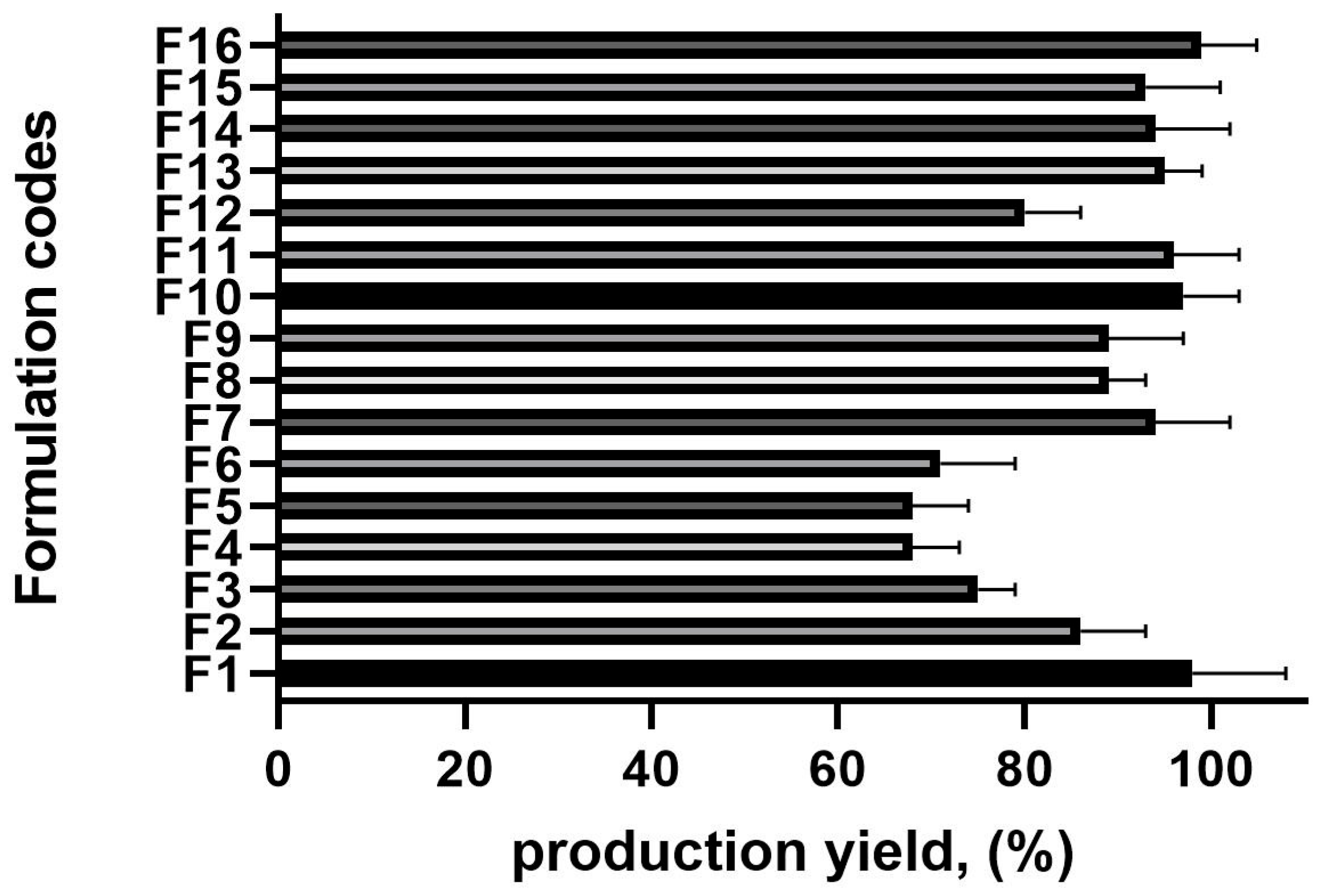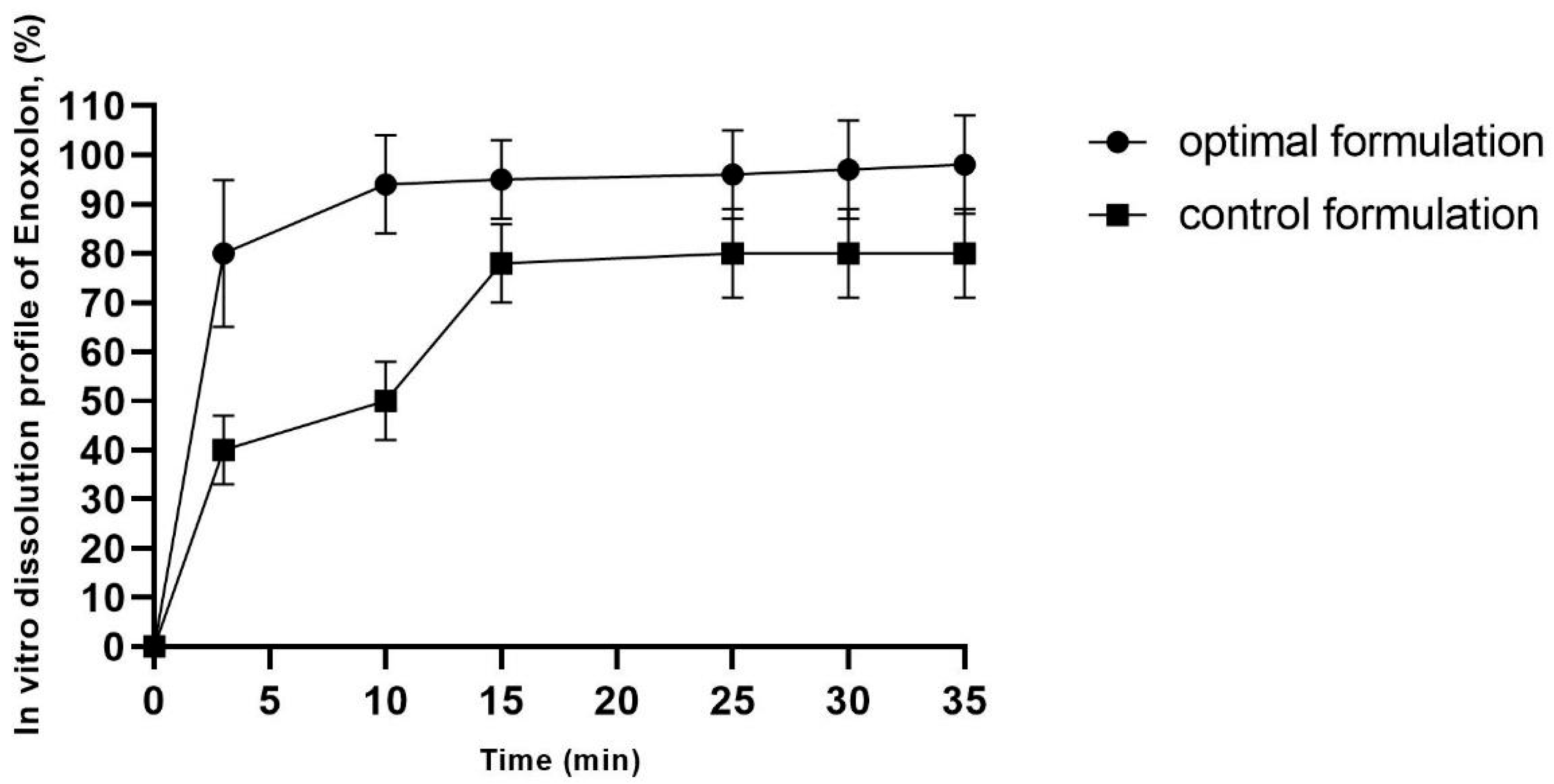Optimized Enoxolone-Loaded Microsponges for Drug Delivery: A Design of Experiments Approach
Abstract
1. Introduction
2. Results and Discussion
2.1. Preparation of Enoxolon Microsponges
2.2. Statistical Analysis Using D-Optimal Mixture Design
2.3. The Production Yield
2.4. In Vitro Drug Release Study
3. Materials and Methods
3.1. Materials
3.2. Optimization of Microsponge Composition Using D-Optimal Mixture Design
3.3. Preparation of Microsponges
3.4. Particle Size Analysis
3.5. Determination of Yield, Drug Content, and Entrapment Efficiency
3.6. In Vitro Drug Release Studies
3.7. High-Performance Liquid Chromatography Analysis of Enoxolon
3.8. Statistical Analysis of Data
4. Conclusions
Author Contributions
Funding
Institutional Review Board Statement
Informed Consent Statement
Data Availability Statement
Conflicts of Interest
References
- Pastorino, G.; Cornara, L.; Soares, S.; Rodrigues, F.; Oliveira, M.B.P. Liquorice (Glycyrrhiza glabra): A phytochemical and pharmacological review. Phytother. Res. 2018, 32, 2323–2339. [Google Scholar] [CrossRef]
- Roohbakhsh, A.; Iranshahy, M.; Iranshahi, M. Glycyrrhetinic acid and its derivatives: Anti-cancer and cancer chemopreventive properties, mechanisms of action and structure- cytotoxic activity relationship. Curr. Med. Chem. 2016, 23, 498–517. [Google Scholar] [CrossRef]
- Shaddox, L.M.; Walker, C.B. Treating chronic periodontitis: Current status, challenges, and future directions. Clin. Cosmet. Investig. Dent. 2010, 2, 79–91. [Google Scholar] [CrossRef]
- Socransky, S.S.; Haffajee, A.D.; Cugini, M.A.; Smith, C.; Kent, R.L. Microbial complexes in subgingival plaque. J. Clin. Periodontol. 1998, 25, 134–144. [Google Scholar] [CrossRef] [PubMed]
- Garcia-Arnandis, I.; Guillen, M.I.; Gomar, F.; Pelletier, J.P.; Martel-Pelletier, J.; Alcaraz, M.J. High mobility group box 1 potentiates the pro-inflammatory effects of interleukin-1beta in osteoarthritic synoviocytes. Arthritis Res. Ther. 2010, 12, R165. [Google Scholar] [CrossRef] [PubMed]
- Ding, X.; Alani, A.W.G.; Robinson, J.R. Extended release and targeted drug delivery systems. In Remington the Science and Practice of Pharmacy, 21st ed.; Lippincott, W., Ed.; Wilkins: Philadelphia, PA, USA, 2002; Volume 1, pp. 939–964. [Google Scholar]
- Asghar, L.A.; Chandran, S. Multiparticulate formulation approach to colon specific drug delivery: Current perspectives. J. Pharm. Pharm. Sci. 2006, 9, 327–338. [Google Scholar] [PubMed]
- Osmani, R.A.; Aloorkar, N.H.; Kulkarni, A.S.; Harkare, B.R.; Bhosale, R.R. A new cornucopia in topical drug delivery: Microsponge technology. Asian J. Pharm. Sci. Technol. 2014, 4, 48–60. [Google Scholar]
- Srivastava, R.; Pathak, K. Microsponges: A futuristic approach for oral drug delivery. Expert Opin. Drug Deliv. 2012, 9, 863–878. [Google Scholar] [CrossRef]
- Aloorkar, N.H.; Kulkarni, A.S.; Ingale, D.J.; Patil, R.A. Microsponges as innovative drug delivery systems. Int. J. Pharm. Sci. Nanotechnol. 2012, 5, 1597–1606. [Google Scholar]
- Bhatt, V.; Karakoti, R.; Singh, A.K.; Sharma, D.K. Microsponges: A novel approach for drug delivery system. World J. Pharm. Res. 2014, 3, 318–334. [Google Scholar]
- Salari, M.H.; Sohrabi, N.; Kadkhoda, Z.; Khalili, M.B. Antibacterial effects of enoxolone on periodontopathogenic and capnophilic bacteria isolated from specimens of periodontitis patients. Iran. Biomed. J. 2003, 7, 39–42. [Google Scholar]
- Baranauskaite-Ortasöz, J.; Üner, B. Preparation and Characterization Studies of Nanofiber and Orodispersable Film Formulations of Enoxolone. J. Res. Pharm. 2022, 26, 1242. [Google Scholar]
- Jadhav, N.; Patel, V.; Mungekar, S.; Bhamare, G.; Karpe, M.; Kadams, V. Microsponge delivery system: An updated review, current status and future prospects. J. Sci. Innov. Res. 2013, 2, 1097–1110. [Google Scholar]
- Bhuptani, R.S.; Patravale, V.B. Starch microsponges for enhanced retention and efficacy of topical sunscreen. Mater. Sci. Eng. C Mater. Biol. Appl. 2019, 104, 109882. [Google Scholar] [CrossRef]
- Zaman, M.; Qureshi, S.; Sultana, K.; Hanif, M.; Mahmood, A.; Shaheryar, Z.A.; Gulzar, F.; Barkat, K.; Abdel-Daim, M.M. Application of quasi-emulsification and modified double emulsification techniques for formulation of tacrolimus microsponges. Int. J. Nanomed. 2018, 13, 4537–4548. [Google Scholar] [CrossRef]
- Osmani, R.A.M.; Aloorkar, N.H.; Thaware, B.U.; Kulkarni, P.K.; Moin, A.; Hani, U.; Srivastava, A.; Bhosale, R.R. Microsponge based drug delivery system for augmented gastroparesis therapy: Formulation development and evaluation. Asian J. Pharm. Sci. 2015, 10, 442–451. [Google Scholar] [CrossRef]
- Bentley, E.R.; Subick, S.; Pezzillo, M.; Balmert, S.C.; Herbert, A.; Little, S.R. Identification and Characterization of Critical Processing Parameters in the Fabrication of Double-Emulsion Poly(lactic-co-glycolic) Acid Microparticles. Pharmaceutics 2024, 16, 796. [Google Scholar] [CrossRef] [PubMed]
- Martinez-Borrajo, R.; Diaz-Rodriguez, P.; Landin, M. Rationalized design to explore the full potential of PLGA microspheres as drug delivery systems. Drug Deliv. 2023, 30, 2219864. [Google Scholar] [CrossRef]
- Yasin, H.; Al-Taani, B.; Salem, M.S. Preparation and characterization of ethylcellulose microspheres for sustained-release of pregabalin. Res. Pharm. Sci. 2021, 16, 1–15. [Google Scholar] [CrossRef]
- Osmani, R.A.M.; Aloorkar, N.H.; Ingale, D.J.; Kulkarni, P.K.; Hani, U.; Bhosale, R.R.; Dev, D.J. Microsponges based novel drug delivery system for augmented arthritis therapy. Saudi Pharm. J. 2015, 23, 562–572. [Google Scholar] [CrossRef]
- Swetha, A.; Rao, M.G.; Ramana, K.V.; Basha, B.N.; Reddy, V.K. Formulation and in vitro evaluation of etodolac entrapped in microsponge based drug delivery system. Int. J. Pharm. 2011, 1, 73–80. [Google Scholar]
- Singh, N. Effect of surfactants on PVA borax hydrogel rheology and thermal aspects. Indian J. Chem. 2013, 52A, 879–883. [Google Scholar]
- Jain, V.; Singh, R. Dicyclomine-loaded Eudragit®-based Microsponge with Potential for Colonic Delivery: Preparation and Characterization. Trop. J. Pharm. Res. 2010, 9, 52039. [Google Scholar] [CrossRef]
- Mandal, T.K.; Bostanian, L.A.; Graves, R.A.; Chapman, S.R.; Idodo, T.U. Porous biodegradable microparticles for delivery of pentamidine. Eur. J. Pharm. Biopharm. 2001, 52, 91–96. [Google Scholar] [CrossRef]
- Orlu, M.; Cevher, E.; Araman, A. Design and evaluation of colon specific drug delivery system containing flurbiprofen microsponges. Int. J. Pharm. 2006, 318, 103–117. [Google Scholar] [CrossRef]
- Liang, J.; Peng, X.; Zhou, X.; Zou, J.; Cheng, L. Emerging applications of drug delivery systems in oral infectious diseases prevention and treatment. Molecules 2020, 25, 516. [Google Scholar] [CrossRef]
- Kalsi, R.; Vandana, K.L.; Prakash, S. Effect of local drug delivery in chronic periodontitis patients: A meta-analysis. J. Indian Soc. Periodontol. 2011, 15, 304–309. [Google Scholar]
- Özdemir, S.; Üner, B.; Baranauskaite, J.; Sümer, E.; Yıldırım, E.; Yaba, A. Design and characterization of dexamethasone loaded microsponges for the management of ulcerative colitis. Eur. J. Pharm. Biopharm. 2023, 187, 34–45. [Google Scholar] [CrossRef]
- Arya, P.; Pathak, K. Assessing the viability of microsponges as gastro retentive drug delivery system of curcumin: Optimization and pharmacokinetics. Int. J. Pharm. 2014, 460, 1–12. [Google Scholar] [CrossRef]
- Junqueira, M.V.; Bruschi, M.L. A review about the drug delivery from microsponges. AAPS PharmSciTech. 2018, 19, 1501–1511. [Google Scholar] [CrossRef]
- Guideline, I.H.T. Validation of analytical procedures: Text and methodology. Q2 (R1) 2005, 1, 5. [Google Scholar]
- Tiškus, R. Liposomų su Paprastųjų Saldymedžių (Glycyrrhiza glabra L.) Šaknų Ekstraktu Gamyba ir Analizė Efektyviosios Skysčių Chromatografijos Metodu. Master’s Thesis, Lithuanian University of Health Sciences, Kaunas, Lithuania, 2024. [Google Scholar]


| Formulation Codes | Enoxolon (%; X1) | MC (%; X2) | PVA (%; X3) | TW 80 (%; X4) | EE (%; Y1) | Size (µm; Y2) |
|---|---|---|---|---|---|---|
| F1 | 0.1 | 1.53 | 0.87 | 1.50 | 63.8 ± 1.83 | 228.3 ± 6.5 |
| F2 | 0.1 | 1.59 | 0.62 | 1.68 | 68.02 ± 2.09 | 258.0 ± 10.8 |
| F3 | 0.1 | 1.18 | 0.50 | 2.22 | 76.3 ± 1.26 | 230.8 ± 6.1 |
| F4 | 0.1 | 0.95 | 0.50 | 2.45 | 74.8 ± 0.54 | 228.1 ± 14.1 |
| F5 | 0.1 | 1.46 | 0.50 | 1.93 | 74.6 ± 1.69 | 195.5 ± 9.3 |
| F6 | 0.1 | 1.87 | 0.50 | 1.54 | 59.3 ± 1.84 | 303.4 ± 12.2 |
| F7 | 0.1 | 0.55 | 0.85 | 2.50 | 75.02 ± 2.24 | 203.1 ± 10.4 |
| F8 | 0.1 | 1.22 | 0.68 | 1.99 | 75.7 ± 1.37 | 154.7 ± 12.1 |
| F9 | 0.1 | 0.84 | 0.79 | 2.28 | 78.21 ± 1.19 | 216.7 ± 14.3 |
| F10 | 0.1 | 1.22 | 0.69 | 1.99 | 81.02 ± 1.99 | 142.2 ± 7.28 |
| F11 | 0.1 | 0.89 | 1.00 | 2.01 | 78.69 ± 2.24 | 141.8 ± 6.14 |
| F12 | 0.1 | 0.89 | 1.00 | 2.01 | 78.03 ± 1.87 | 143.5 ± 9.24 |
| F13 | 0.1 | 1.22 | 0.68 | 1.99 | 80.3 ± 1.99 | 142.8 ± 10.02 |
| F14 | 0.1 | 1.53 | 0.87 | 1.50 | 58.3 ± 1.04 | 228.7 ± 9.88 |
| F15 | 0.1 | 0.55 | 0.85 | 2.50 | 74.2 ± 1.66 | 203.4 ± 3.73 |
| F16 | 0.1 | 1.19 | 1.00 | 1.70 | 70.3 ± 1.03 | 148.3 ± 9.2 |
| Response | Model | R2 | R2 Predicted | R2 Adjusted | Std Dev. |
|---|---|---|---|---|---|
| Particle size | Quadratic | 0.9234 | 0.8234 | 0.9245 | 21.45 |
| Encapsulation efficiency | Quadratic | 0.9901 | 0.9234 | 0.9678 | 10.12 |
| Independent Variables | |||
|---|---|---|---|
| Ingredients | Amount Levels (%) | Predicted Optimal Amount (%) | |
| Enoxolon | 0.1 | 0.1 | |
| MC | 0.5–1.9 | 1.09 | |
| PVA | 0.5–1.0 | 0.67 | |
| TW 80 | 1.5–2.5 | 2.14 | |
| Response variables | |||
| Criteria | Predicted | Obtained | |
| Particle size (µm) | Minimize | 141.8 ± 18.4 | 142.34 ± 8.2 |
| Encapsulation efficiency (%) | Maximize | 79.50 ± 1.9 | 78.96 ± 2.4 |
Disclaimer/Publisher’s Note: The statements, opinions and data contained in all publications are solely those of the individual author(s) and contributor(s) and not of MDPI and/or the editor(s). MDPI and/or the editor(s) disclaim responsibility for any injury to people or property resulting from any ideas, methods, instructions or products referred to in the content. |
© 2025 by the authors. Licensee MDPI, Basel, Switzerland. This article is an open access article distributed under the terms and conditions of the Creative Commons Attribution (CC BY) license (https://creativecommons.org/licenses/by/4.0/).
Share and Cite
Baranauskaite, J.; Sefer, S.; Zevzikoviene, A.; Zevzikovas, A.; Ivanauskas, L. Optimized Enoxolone-Loaded Microsponges for Drug Delivery: A Design of Experiments Approach. Pharmaceuticals 2025, 18, 938. https://doi.org/10.3390/ph18070938
Baranauskaite J, Sefer S, Zevzikoviene A, Zevzikovas A, Ivanauskas L. Optimized Enoxolone-Loaded Microsponges for Drug Delivery: A Design of Experiments Approach. Pharmaceuticals. 2025; 18(7):938. https://doi.org/10.3390/ph18070938
Chicago/Turabian StyleBaranauskaite, Juste, Sedef Sefer, Augusta Zevzikoviene, Andrejus Zevzikovas, and Liudas Ivanauskas. 2025. "Optimized Enoxolone-Loaded Microsponges for Drug Delivery: A Design of Experiments Approach" Pharmaceuticals 18, no. 7: 938. https://doi.org/10.3390/ph18070938
APA StyleBaranauskaite, J., Sefer, S., Zevzikoviene, A., Zevzikovas, A., & Ivanauskas, L. (2025). Optimized Enoxolone-Loaded Microsponges for Drug Delivery: A Design of Experiments Approach. Pharmaceuticals, 18(7), 938. https://doi.org/10.3390/ph18070938








